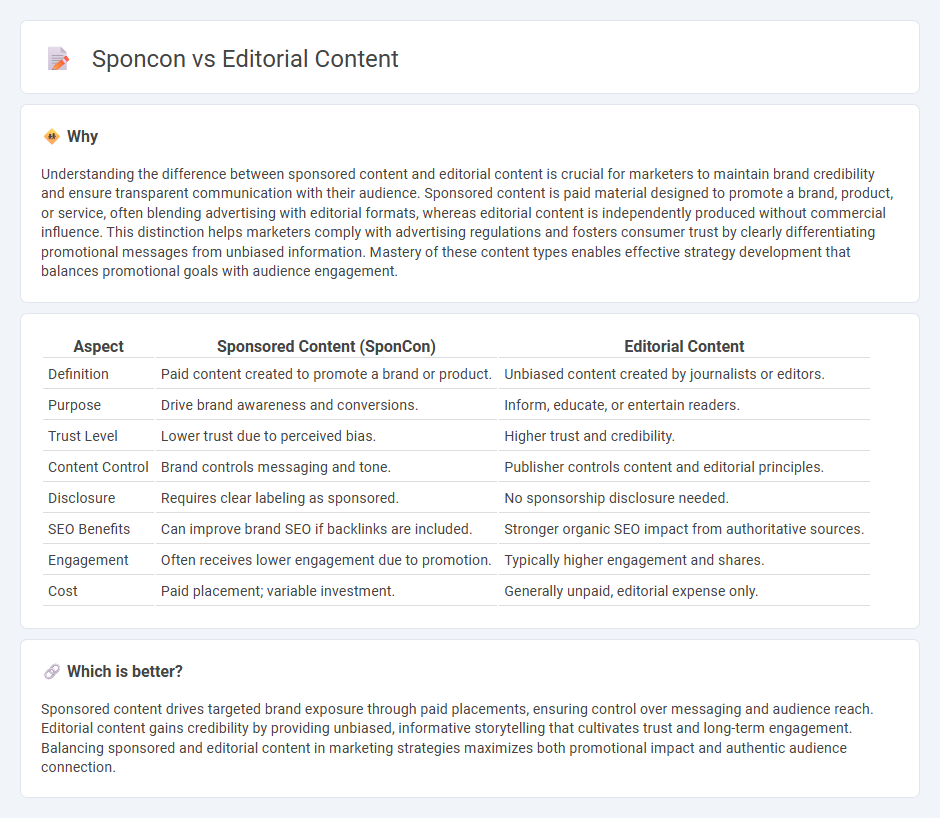
Sponsored content merges brand messaging with editorial storytelling to engage audiences authentically, boosting brand awareness and trust through native advertising techniques. Editorial content delivers unbiased, informative material that fosters credibility and loyal readership by prioritizing value over promotion. Discover how balancing sponcon and editorial strategies can optimize your marketing impact.
Why it is important
Understanding the difference between sponsored content and editorial content is crucial for marketers to maintain brand credibility and ensure transparent communication with their audience. Sponsored content is paid material designed to promote a brand, product, or service, often blending advertising with editorial formats, whereas editorial content is independently produced without commercial influence. This distinction helps marketers comply with advertising regulations and fosters consumer trust by clearly differentiating promotional messages from unbiased information. Mastery of these content types enables effective strategy development that balances promotional goals with audience engagement.
Comparison Table
| Aspect | Sponsored Content (SponCon) | Editorial Content |
|---|---|---|
| Definition | Paid content created to promote a brand or product. | Unbiased content created by journalists or editors. |
| Purpose | Drive brand awareness and conversions. | Inform, educate, or entertain readers. |
| Trust Level | Lower trust due to perceived bias. | Higher trust and credibility. |
| Content Control | Brand controls messaging and tone. | Publisher controls content and editorial principles. |
| Disclosure | Requires clear labeling as sponsored. | No sponsorship disclosure needed. |
| SEO Benefits | Can improve brand SEO if backlinks are included. | Stronger organic SEO impact from authoritative sources. |
| Engagement | Often receives lower engagement due to promotion. | Typically higher engagement and shares. |
| Cost | Paid placement; variable investment. | Generally unpaid, editorial expense only. |
Which is better?
Sponsored content drives targeted brand exposure through paid placements, ensuring control over messaging and audience reach. Editorial content gains credibility by providing unbiased, informative storytelling that cultivates trust and long-term engagement. Balancing sponsored and editorial content in marketing strategies maximizes both promotional impact and authentic audience connection.
Connection
Sponsored content and editorial content intersect in marketing by blending promotional messages with authentic storytelling to engage target audiences more effectively. Sponsored content adopts the tone and style of editorial content to build trust and credibility while subtly promoting a brand or product. This fusion enhances brand visibility and drives consumer action by delivering valuable, relevant information within a familiar editorial framework.
Key Terms
Authenticity
Editorial content maintains authenticity by delivering unbiased, valuable information crafted by independent journalists or experts, enhancing trust and credibility with audiences. Sponsored content, while often blending seamlessly with editorial material, risks perceived bias due to its promotional nature and brand-driven objectives. Explore the key differences to better understand how authenticity shapes audience engagement.
Disclosure
Editorial content maintains unbiased reporting and editorial independence, ensuring that information is presented without influence from external commercial interests. Sponsored content (sponcon) requires clear and prominent disclosure to differentiate promotional material from genuine editorial work, adhering to FTC guidelines and industry standards. Explore our detailed guide on disclosure best practices to ensure transparency and trust in your content.
Audience Trust
Editorial content maintains audience trust by providing unbiased, fact-checked information crafted by experienced journalists, ensuring credibility and authenticity. Sponsored content often blends promotional messages with editorial style, which can blur transparency and reduce trust if the audience perceives commercial bias. Discover more about balancing compelling storytelling and ethical advertising to enhance audience loyalty.
Source and External Links
What Is Editorial Content & How Is It Used? - Claspo - Editorial content is created to inform, entertain, or engage, comprising elements like headline, introduction, body, conclusion, and often a call to action, designed to deliver cohesive, valuable narratives to the audience.
Editorial Content: What It Is and Why It Is Important - Casted - Editorial content includes blogs, podcasts, newsletters, and social posts aiming to provide value through insight rather than direct selling, helping build trust and authority with the audience.
What Is Editorial Content in Journalism? | NYTLicensing - In journalism, editorial content refers to opinion or interpretive pieces meant to persuade or inform readers on current issues and can include criticism, appreciation, or entertainment editorials.
 dowidth.com
dowidth.com